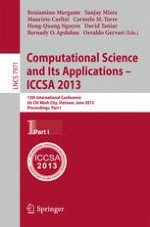2013 | Book
Computational Science and Its Applications – ICCSA 2013
13th International Conference, Ho Chi Minh City, Vietnam, June 24-27, 2013, Proceedings, Part I
Editors: Beniamino Murgante, Sanjay Misra, Maurizio Carlini, Carmelo M. Torre, Hong-Quang Nguyen, David Taniar, Bernady O. Apduhan, Osvaldo Gervasi
Publisher: Springer Berlin Heidelberg
Book Series : Lecture Notes in Computer Science
